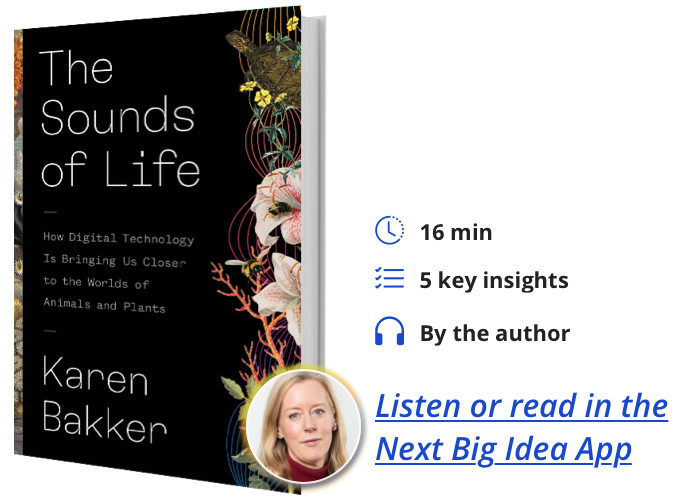Karen Bakker is a Professor at the University of British Columbia, and a Fellow at the Harvard Radcliffe Institute for Advanced Study. She is a Rhodes Scholar with a PhD from Oxford. Bakker’s current research focuses on the intersection of digital technologies and environmental governance, digital environmental humanities, digital geographies, political ecology, and political economy.
Below, Karen shares 5 key insights from her new book, The Sounds of Life: How Digital Technology is Bringing Us Closer to the World of Animals and Plants. Listen to the audio version—read by Karen herself—in the Next Big Idea App.

1. Human ears cannot hear all of nature’s symphony.
When you step into a forest or walk along a beach, there’s a lot to take in: the sound of waves crashing against the sand, birds chirping to each other in the trees, but there is also a lot we don’t hear. A large degree of the communication that happens in nature is inaudible to us. This communication happens either above the top end of our hearing range in what’s called the ultrasonic or below the lower end of our hearing range in what’s called the infrasonic.
Bats and dolphins, for example, communicate and echolocate in a high frequency range, the ultrasonic. Whales, elephants, and tigers can both hear and make sound in the infrasonic, below our hearing range. Recently, scientists have begun recording a large number of other species and we are realizing that a huge range of species makes sounds. Nearly every living organism we have studied is sensitive to sound.
Imagine walking into a room blindfolded. You can’t see who is there. In fact, you don’t know if anyone is there at all. Our human hearing range is so limited that it’s as if we were moving through the world with blindfolds on our ears. We can’t hear the sounds that most creatures make, and in most cases we can’t even perceive that they are making any sound at all.
As humans, we often tend to believe that what we cannot observe does not exist. That’s why so many new scientific findings are so surprising.
2. Digital listening brings us closer to nature.
Digital tech is often thought to distance us from nature, but digital listening actually brings us closer. Imagine taking your smartphone and opening an app that records sound—including sound above and below your hearing range. It would be like having an enormously powerful hearing aid. Now imagine linking up a network of these phones, across a forest, or even an entire ocean.
“Many more creatures make sound—lots more sound, and very intricate sound—than we previously knew.”
This is exactly what scientists are doing. They are using digital bioacoustics—portable, automated recording devices—to record the sounds of other species, from the Arctic to the Amazon, 24 hours a day, seven days a week, 365 days a year, with far less disruption than human observers usually cause.
Digital listening is enabling scientists to discover astounding things about nature. Many more creatures make sound—lots more sound, and very intricate sound—than we previously knew. One example is the famous dance of the peacock, with the beautiful tail that fans out. It is one of the most famous, beautiful mating displays in nature. Humans assume this is a visual display. But it turns out that it’s a sonic display. The male peacocks are making very loud sounds with their tails in the infrasonic, sounds that we can’t hear. If you could hear them, it would sound like a loud car revving right next to your ear. The Female peahens can hear these sounds, and in experiments scientists have confirmed that those peahens pay attention to the peacocks that can make the best noises and the biggest noises, which influences their mating choices.
It’s fairly astounding that we only just learned this fact about peacocks. They’re not the only species for which sound is important. Nearly every species that scientists have observed with digital bioacoustics—even those without apparent hearing organs—is sensitive to sound; and many more make sound than we previously understood.
Even more astonishing, scientists have demonstrated that species without any apparent means of hearing are also responsive to sound. Coral and fish larvae navigate across miles of open ocean to healthy reefs, and show a preference for their home reefs. Although scientists do not yet know how, these tiny creatures imprint on the sonic signature of their natal reef at the moment of their birth, like a marine lullaby.
Other experiments demonstrate that some plants make infrasonic sounds at frequencies audible to insects and bats. In one fascinating experiment, flowers increased their production of nectar when exposed to the sound of buzzing bees, flooding with sweetness as if in anticipation. In another experiment, plant seedlings grew their roots towards the sound of running water, even though no moisture gradient was present.
As we learn to listen to nature’s symphony, humans are starting to be aware of the huge range of sounds made by other species, sounds that we cannot hear with our limited human ears. This attunement is what is changing our understanding of the world around us.
3. Non-human language can now be heard as well as understood.
Remember that smartphone app that is helping you listen to nature? Now imagine if it contains an artificial intelligence algorithm, similar to the one that powers Google Translate. Scientists are using artificial intelligence to discern patterns and even decode nonhuman vocal communication. Deciphering individual bat sounds from the cacophony of a cave is impossible for a human listener, but relatively easy for a trained artificial intelligence algorithm.
“Language may not be unique to humans.”
Researchers have found an expanding list of species that refer to one another with individual names (dolphins, belugas, and bats). Some species also use specific referential signals, just like humans use words. Elephants have specific vocal signals for “honeybee” and “human” and their vocalizations are so nuanced that specific signals are used to differentiate between threatening hunters and non-threatening passersby. Turtles utter unique vocal signals at the moment before they hatch, which scientists believe are used to coordinate the mass births for which they are famous.
These findings lend weight to long-debated, controversial claims about the existence of language in non-human species. Language may not be unique to humans. Many species are able to convey complex information through sound. We’re not quite sure how many species possess some of the other hallmarks of language but scientists are now actively trying to find out.
A team of researchers at MIT and Berkeley, for example, is decoding sperm whale communication—which sounds a lot like Morse code. Others have created a dictionary in East African Elephant.
4. Interspecies communication may be possible, but we should first question our motivations for using it.
The idea of speaking with non-humans inspires lots of feelings, from fascination to scorn. Talking animals appear in myths and origin stories in many cultures. Today, some scientists believe we are on the brink of inventing a zoological version of Google Translate.
How would this work? Once artificial intelligence algorithms decode patterns, words, and names in non-human languages, these can be encoded into robots or computers. You or I can’t click like a dolphin or buzz like a bee, but our computers can. A team of researchers in Germany has actually been successful in communicating with honeybees this way.
Other researchers are attempting interspecies communication with dolphins, bats, and whales. These efforts often take the form of playback experiments. In the future, scientists hope to begin answering more complex questions. For example, do elephants have oral history? What are whale songs actually about? We presumed they were songs without words, but what if they are telling stories with their songs?
“You or I can’t click like a dolphin or buzz like a bee, but our computers can.”
There are also many ethical questions here: Do other species want to speak with us? Should we seek consent before we eavesdrop on them? Could interspecies communication create a new way to domesticate non-humans, or will it enable us to develop new relationships, a feeling of kinship, with our cousins on the Tree of life?
5. Noise pollution affects the wellbeing of humans and nonhumans alike.
In the midst of these discoveries, we are also realizing the grave threat posed by noise pollution. Even moderate levels of noise—the kind that surrounds us in any urban environment—increase risks of cardiovascular disease, cognitive impairment, developmental delays, and dementia. Scientists are now finding that non-humans, too, suffer from noise pollution and that they are far more sensitive to it than humans.
Perhaps nowhere is this more urgent than in the global oceans. Marine animals see and sense the world through sound, which travels faster and farther underwater than light. Whales, which use sound to find prey and navigate, communicate and mate, are one well-known example. But scientists are now revealing that a vast range of marine creatures are exquisitely sensitive to sound.
The range of negative effects caused by marine noise pollution is staggering: delayed development, hampered reproduction, stunted growth, and distorted migration paths. Extreme noise can kill outright. A single shot from a seismic survey air gun can kill zooplankton—the foundation of the marine food chain—up to a mile away from the detonation site. Motorboat engine noise has been found to affect fish embryos. As an article in Science grimly noted: human noise is scrambling the eggs of baby fish.
Terrestrial animals and even plants are also sensitive to noise. The good news is that the reduction of noise pollution can have immediate, positive, and significant impacts for non-humans and humans alike. Hushing the human cacophony is a major challenge of our time. Digital listening reveals that we have much more to learn about non-humans, and provides new ways to protect and conserve the environment. Perhaps one day we will invent a zoological version of Google Translate. But, first, we need to learn how to listen.
To listen to the audio version read by author Karen Bakker, download the Next Big Idea App today:































